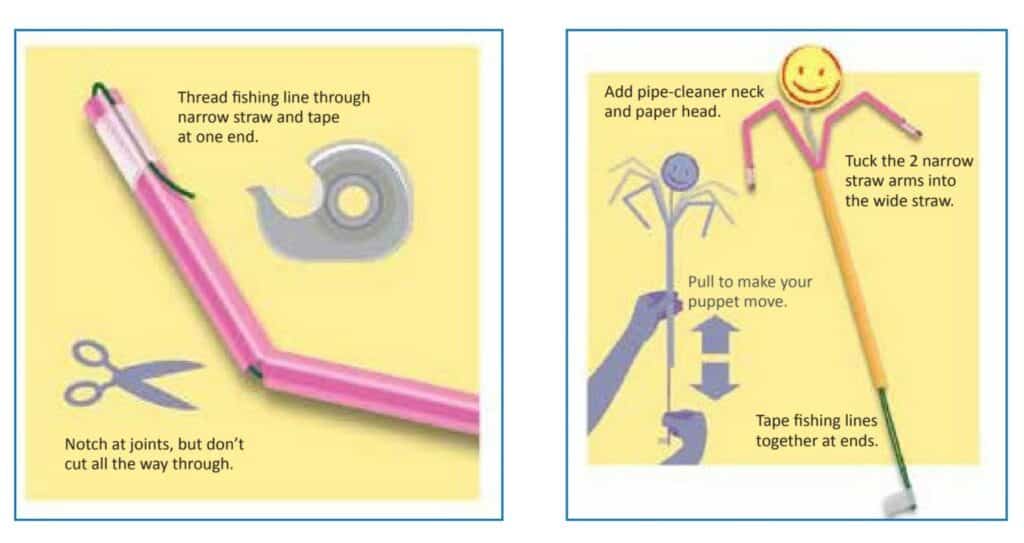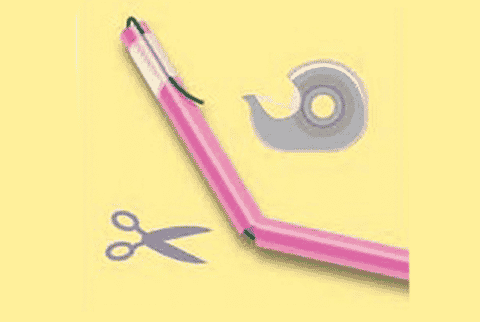Overview
STEM careers
Time
Materials
Per Class:
|
Per Student:
|
Instructions
Students design a puppet out of fishing line and straws and experiment with its elastic properties.
- Tell the students what they are about to do. Show them the example puppet, if you’ve made one.
- Distribute materials.
- The first step is to make notches in the 2 narrow straws, keeping the following in mind (show students the notches on the example puppet if available):
- Where you cut the notches dictates how the straw moves. To make “arms” bend in one direction, make notches along the same side of the straw.
- To make arms bend in different directions, alternate the notches on either side of the straw.
- If joints don’t bend easily, students can cut a slightly deeper notch, but not so deep that the straw can’t go back to its normal shape when it is let go.
- Cut a fishing line 3 times as long as the straw. Thread it through one of the narrow, notched straws.
- When the line pokes through the end of the straw, bend it over the tip and tape it. Leave the other end loose.
- Cut another piece of fishing line and thread it through the second narrow straw.
- Pull the loose lines and watch the straws bend.
- Pull the loose lines of both narrow straws through the wider straw.
- Wedge both narrow straws into the wider straw, enough so that they are secure but not so tightly that the fishing line pieces hanging down can’t slide easily without catching or rubbing.
- Tape the hanging down fishing line together and make a little tape tab to tug. Pull the tab and watch the arms or legs of your puppet move.
- Decorate your puppet with a head, body, eyes, and anything else you can think of!

Guiding questions
-
How does making more notches affect the ability of the straw to go back to its original shape?
-
When you have the fishing line threaded through the narrow straws and pull to make the straws bend, what kind of puppet are you inspired to create?
-
How could you make a dragon or a sea serpent instead of a person puppet?
Engineering & science connections
- Elasticity is the property of a substance that enables it to recover its original shape and size after it has been stretched, squeezed, or bent. All substances are elastic to some degree, but some much more than others.
- By understanding the laws of elasticity, engineers know how a material will respond to certain forces during use. Seismic engineers are now designing elastic bridge connectors that will stretch during an earthquake but then spring back to their original shape.
- In this activity, if the puppet loses its elasticity it will not function. Similarly, if a structure such as a building or plane engine part loses elasticity it can lead to a failure, causing damage or loss of human lives. That’s why engineers need to carefully test new designs.
- Robert Hooke, an English physicist, first explored the theory of elasticity in 1660. He’s the namesake for Hooke’s Law, which states that the extension of a spring or an elastic object is proportional to the stress placed on it. Every spring or elastic object obeys this law, but each object is different in its level of resistance to stretching. Trampolines, retractable pens, rubber bands, and automobile shocks are examples of Hooke’s Law at work.
This activity provided by Design Squad Nation.
Design Squad Nation is produced by WGBH Boston. Major funding is provided by the National Science Foundation. Project funding is provided by Northrop Grumman Foundation and S.D. Bechtel, Jr. Foundation. Additional funding is provided by United Engineering Foundation (ASCE, ASME, AIChE, IEEE, AIME). This DESIGN SQUAD NATION material is based upon work supported by the National Science Foundation under Grant No. EEC-1129342. Any opinions, findings, and conclusions or recommendations expressed in this material are those of the author(s) and do not necessarily reflect the views of the National Science Foundation. TM/© 2012 WGBH Educational Foundation. Design Squad and Design Squad Nation are trademarks or registered trademarks of WGBH Educational Foundation. All rights reserved. All third party trademarks are the property of their respective owners. Used with permission


0 Comments